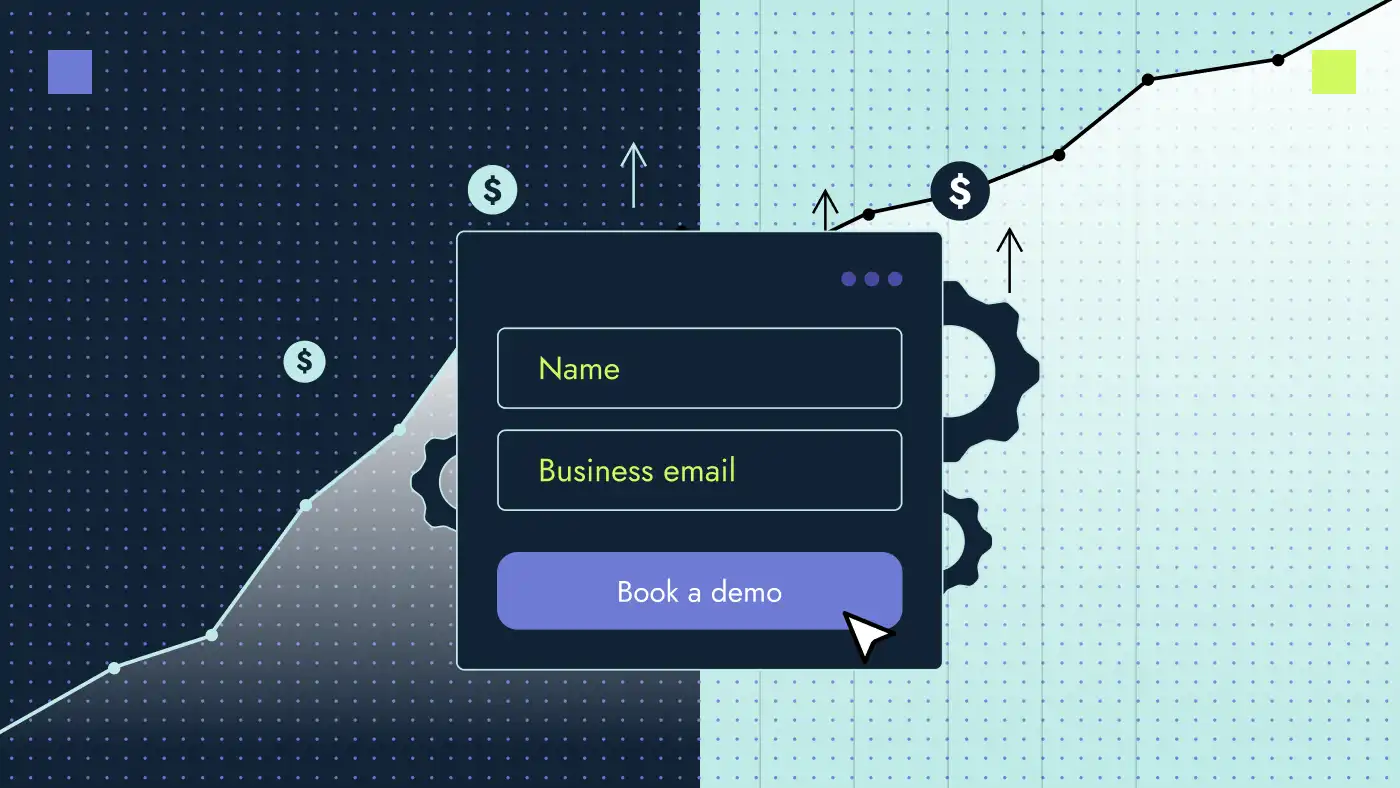Gone are the days when Contact Us pages had never-ending sections, including company goals, hiring processes and a Google map view of the physical office address. As a focal point for conversions, contact pages have evolved, now cutting straight to the chase.
Consider this eye-opening research by Neilsen Norman Group: there’s an astonishing 84% difference in how users interact with the information above the fold compared to what’s hidden below. This statistic underscores the importance of having a Contact Us page that is well-designed and user-friendly. After all, the conversion rate on your SaaS website is the make-or-break factor that either propels your business to new heights or leaves you struggling to gain traction.
Let’s review the latest trends and best practices for building contact pages that help optimize your conversion rates.
Why a strong B2B contact page is critical to lead generation

With a well-structured contact page, you:
- Ensure that visitors quickly find essential information, such as your contact details or a contact form.
- Encourage customer engagement. Whether it’s an inquiry, feedback or partnership proposal, your contact form lets visitors initiate a conversation, fostering a sense of connection and involvement with your brand.
- Build trust with your audience, signaling transparency and showing that your business is open to communication, which is crucial for establishing credibility with potential leads.
The evolution of the Contact Us page
Over the ways, Contact Us pages have evolved to meet the changing needs of customers and businesses, influenced by the advances in technology, design trends, shifts in user behavior and, most importantly, the changes in the attention span of users.
Here are the latest developments:
- Mobile responsiveness: Statista says mobile users will reach more than 7.4 billion in 2024. With the rapid increase of mobile users, your Contact Us page must prioritize a seamless tablet and smartphone experience.
- Interactive elements: The modern-day Contact Us page includes interactivity features like chatbots for real-time support to encourage user engagement and automated communication processes. Dynamic forms have also been impactful tools to increase interactivity on the page.
- Personalized and localized Contact Us page: Global businesses with multilingual websites showcase the local versions of the Contact Us pages to meet diverse audiences’ language preferences. This personalization (e.g., displaying the user’s language preference based on browsing history) contributes to a more user-centric experience.
- User-friendly contact forms: The design of contact forms has become more user-friendly, focusing on simplicity and clarity. Progressive forms fields, conditional logic and visual cues guide users to complete the action while reducing friction.
- Rich media: Including rich media, such as videos and audio testimonials, has become more prevalent on Contact Us pages. Visual elements enhance the overall user experience and provide additional context about the business.
- Analytics and user insights: Businesses increasingly use tools like Google Analytics to gather insights into user interactions like clicks, conversions and bounce rates on Contact Us pages. This data-driven approach helps optimize the design and content of these pages to meet user needs and preferences.
- Integration with CRM platforms: Contact Us pages are now often integrated with customer relationship management (CRM) systems, ensuring a seamless flow of information between user inquiries and the organization’s customer management processes.
- Security and privacy acknowledgment: Data privacy laws like CCPA, GDPR and CPRA have required companies to gather consent regarding using their audiences’ information. Contact Us pages now include information about measures to protect user data. This transparency builds trust with the visitors. Here’s an example from the cloud-based content management platform Box, whose contact page has a disclaimer about the company’s terms of service and privacy policy.
7 Contact Us page best practices with examples
When crafting high-converting Contact Us pages, follow our best practices:
1. Make your contact page easy to find
When helping your clients navigate your B2B SaaS company’s website, ensure their journey is as smooth as possible. And that starts with the call to action (CTA) leading to your contact page.
Your CTA can vary depending on your offerings: Contact Us, Get Started or Book a Demo are typically effective. The key is to pick a term that your customers easily recognize. Also, ensure that it is prominently displayed and doesn’t look similar to other links in your website navigation.
Here’s an example from our website. “Become a client” is our CTA.
2. Humanize your message and tone
Remember that humanizing your contact landing page is all about your tone of voice and overall user experience. Make it easy for customers to reach you and feel like they are engaging with real people who care about their needs.
Here are my tips for connecting with the buyer personas:
Use conversational language
Conversational language is more straightforward, ensuring your message is clear and easily understood. Informal language invites users to engage in a two-way dialogue.
Here’s an example from Tonic, which uses a conversational tone on its Contact Us page.
Validate the pain points of your target audience
If a user has made it to the contact page of your website, they are most likely in the consideration phase of the sales funnel. At this point, they want validation of their pain points to convert. Highlight your solutions to their challenges in the simplest way possible.
See how Pathlight’s demo page validates pain points in the description.
Provide direct contact information
In the contemporary B2B SaaS world, the objective or goal of the page is everything. If you aim to have a support section on the Contact Us page, adding direct contact details like email, office address or contact number would help rank the page in the search engine.
Here is an example from Exclaimer, with information on how to contact their multiple locations.
Share the customer success stories
Adding value propositions like testimonials on the Contact Us page adds credibility, validates the product and makes filling out the contact form worthwhile.
Below is an example from Brinqa, which leverages testimonials to make the case for its cybersecurity platform.
Use visuals
One of the latest trends on Contact Us pages is the use of moving images and GIFs. The best practice is to use more visuals and less text, as it helps absorb content quicker.
See how Keepgrading uses motion graphics to make their Contact Us page engaging.
3. Follow the “less is more” approach to your advantage
The end goal of your contact page is to ensure the user who fills out that form will be a potential lead for your sales team. That’s why you need to keep the page to a minimum.
Here’s how to prevent users from getting distracted from the aim:
- Refrain from using internal links on this page as they might distract the customer from completing the form.
- Ensure the intention of the page is evident to the user. For example, if the intent is to fill out a form, it should be clear.
- Make the form visible on the first screen without scrolling.
- Shorten the form as much as possible with minimum fields. Users don’t like to fill the infinite forms.
Here is an example of the minimalist design of Unit’s contact page.
4. Customize your contact page for different scenarios
There’s no one-size-fits-all design for a Contact page, as each customer may have different needs and the information you provide can change over time. That’s why some companies have adopted “adaptive” Contact pages that cater to various customer requests.
Zapier, for example, prompts visitors to categorize their issues, leading to different forms asking for more specific details.
Campaign Monitor takes a time-based approach, displaying alerts during live service interruptions and offering varying support options based on the time of day. For logged-in customers, they provide a phone number if their plan includes phone support. There’s also a sidebar on their Contact Us page that features an email marketing guide for visitors in the funnel’s consideration phase.
5. Showcase social proofs
Incorporating social proofs on the Contact Us page can boost conversions by instilling trust, addressing potential concerns and providing real-world evidence of the value of your product or service.
Social proofs include:
- Testimonials
- Reviews
- Logos of well-known clients
When visitors see that others have had positive experiences with your business, it instills confidence and credibility. See how Dotmatics showcased their clientele logos on the Contact Us page:
6. Ensure your CRM is linked to the contact form
When a visitor fills out the contact form, the information should be automatically sent to your CRM, eliminating manual data entry errors. For a streamlined lead management process, ensure there’s a correct linkage between your conversion form and the CRM system
And don’t forget to test the form fields and look for any fixes required before making the page live.
7. Set expectations for the response time
Clear expectations for response time on your contact page with an acknowledgment you received the form are crucial for a positive user experience. This step brings an opportunity to include a multi-channel approach by adding social media links with a thank you note.
Here is an example of social media links on Acquisio’s Thank You page.
Need more inspiration? Here are great examples of contact pages
I’ve compiled my favorites with some details on why I think their Contact Us pages are great examples.
1. Dialpad
Dialpad is a customer intelligence platform. Their Contact Us page is simple and inviting, with minimal form fields.
2. PandaDoc
PandaDoc is a document automation software. Their entire Contact Us page is visible on the main screen with no distractions for the user. They have also done a great job hiding their menu items on this page.
3. Databricks
Databricks is a data intelligence platform. By looking at their Contact Us page, you clearly understand the reasons to fill the form with checkmarks on the left side, simply highlighting the value propositions of their product.
4. AuditBoard
AuditBoard is a cloud-based platform for audit, risk, ESG and compliance management. Their Contact Us page has brief form fields encouraging users to fill the form instantly. They also have a checkbox to filter out the leads in the simplest way.
I like the choice of imagery on the page, which features their product’s wireframe with the G2 top 100 rating badge overlapping it. This indication that their product is a winner helps to add more value to filling out the form. Plus, their data privacy disclaimer is mentioned in an informal tone, making it more accessible for the readers.
5. Vonage
Vonage is a cloud-based communication tool for businesses. They have listed a phone number in the description of their Contact Us page, which adds authenticity and trust for the potential customer. Also, listing global customer logos is a good demonstration of social proof.
Unlock higher conversion rates with Productive Shop
Need help revamping your contact page to engage and convert prospects? We would love to help. Our team specializes in unlocking higher conversion rates for B2B SaaS clients.
How? By strategically crafting optimized website pages that align seamlessly with the objectives and goals of tech startups.
Take a peek at our own Contact Us page. Fill out the form and we’ll get back to you with the best strategies to optimize your conversions.























